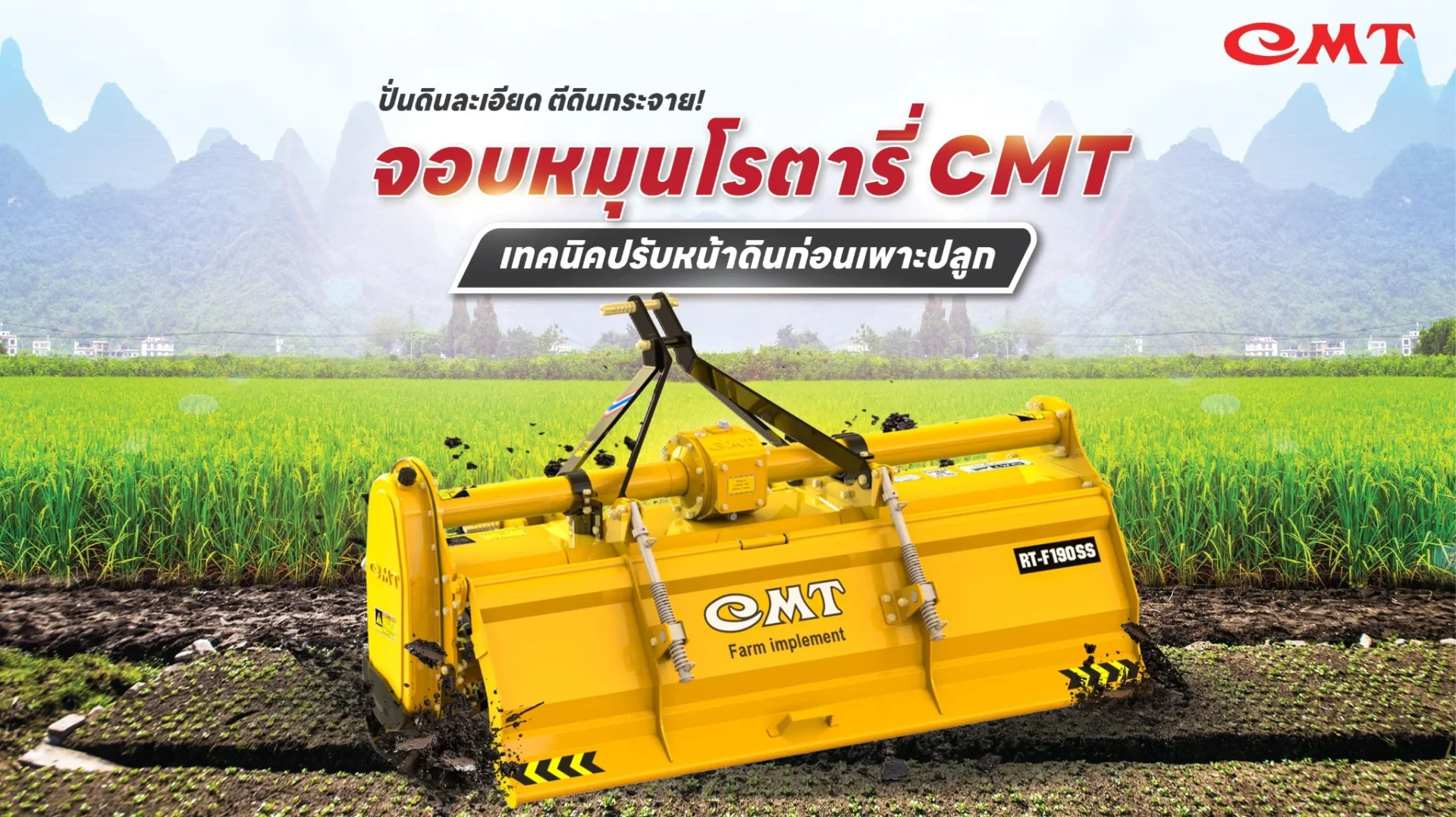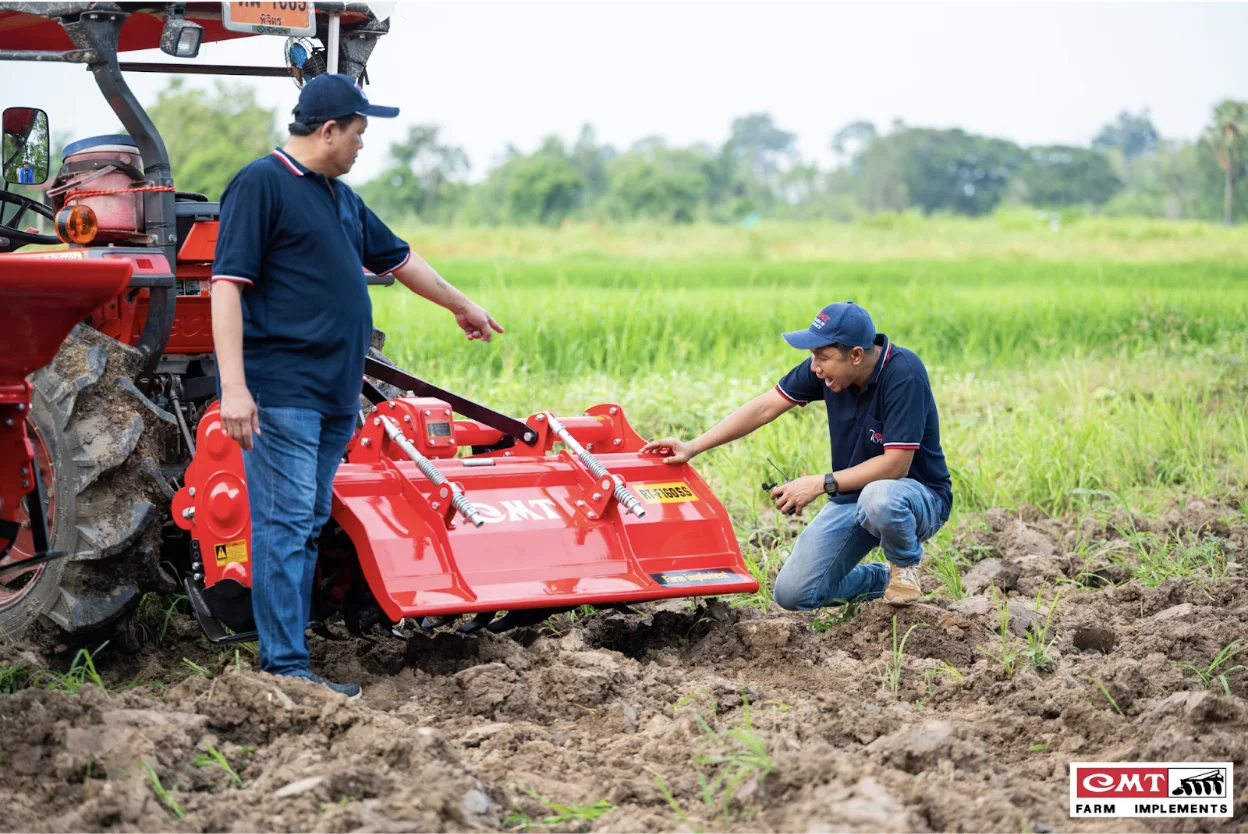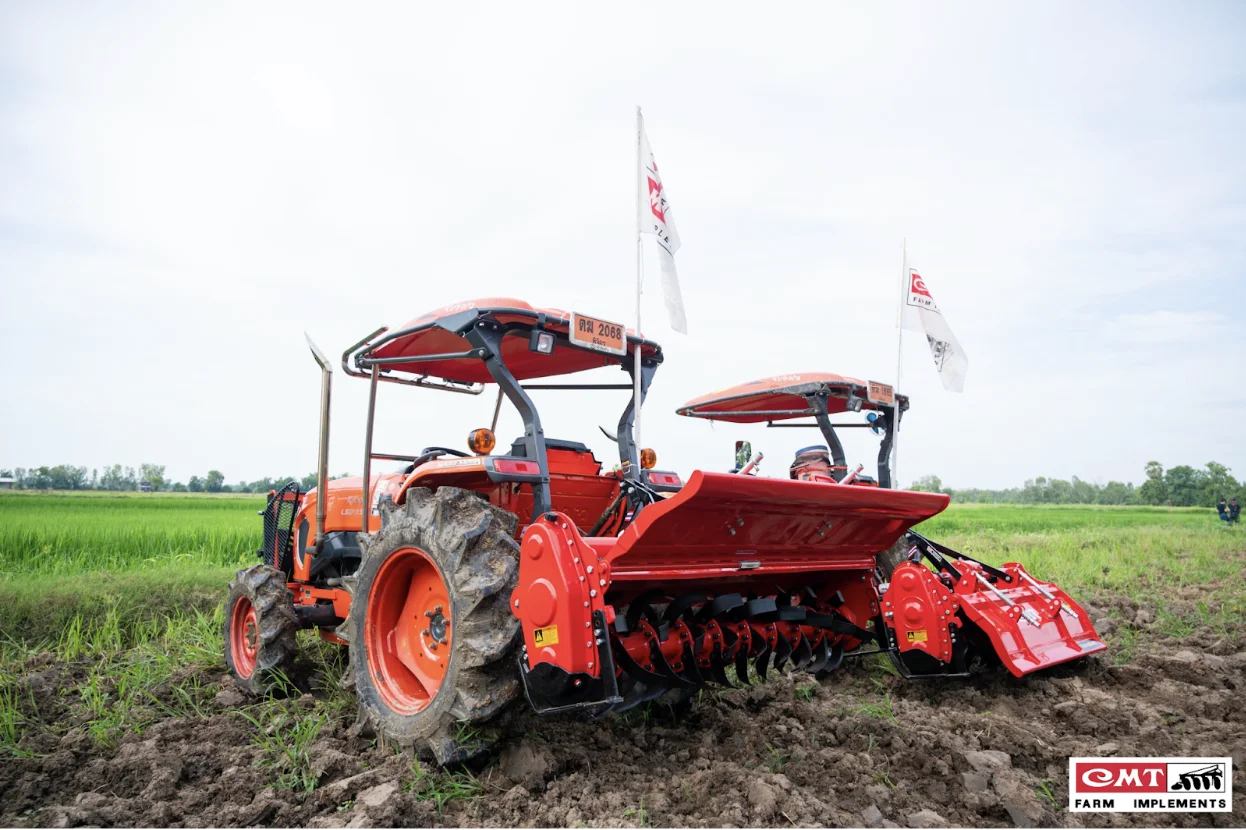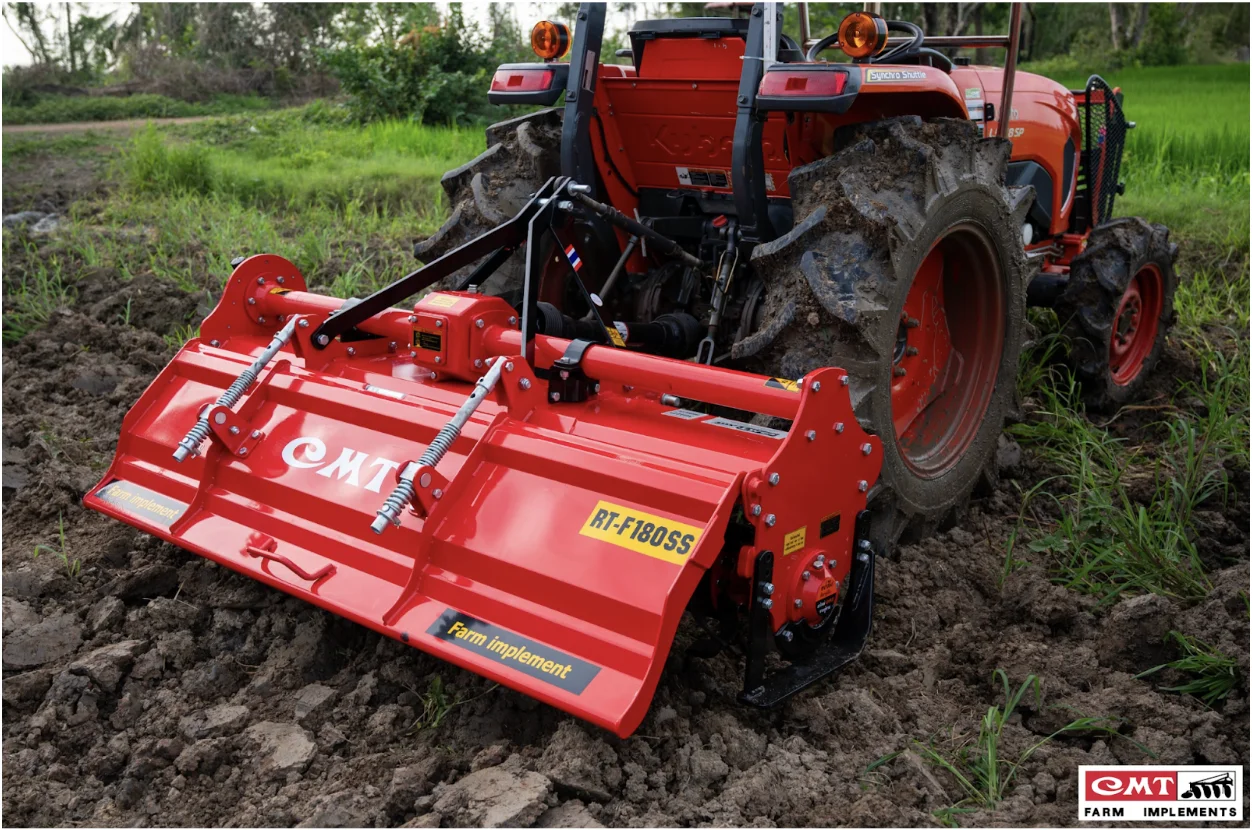Finely grind the soil, beat the soil with a rotary tiller, and adjust the soil before planting.

Rotary tillers break up and spread the soil finely, making it ready for planting.
Say goodbye to compacted topsoil and poor soil structure that slows plant growth!
If youre a farmer looking for an efficient way to prepare your land for cultivation quickly and effectively, the rotary tiller is your essential solution. This implement, when attached to a tractor, helps break up and finely crumble the soil, improving soil structure and readiness for planting.
With a rotary tiller, soil preparation becomes easier, faster, and more efficientsaving you significant time in the field while ensuring your crops get the best start possible.
What is a Rotary Tiller and How Does It Work?
A rotary tiller is a tractor-mounted implement equipped with high-speed rotating blades designed to break up, loosen, and mix soil efficiently. It helps farmers prepare the land faster and more effectively by simultaneously tilling the soil, turning over the top layer, and eliminating weeds.
Key Working Principles:
- The tiller typically features 48 to 66 blades that rotate at high speeds.
- These blades crush and refine the soil, making it loose and well-aeratedideal for plant growth.
- It can incorporate weeds and plant residues into the soil, increasing organic matter and essential nutrients.
- The rotary tiller is suitable for wet soil, dry soil, and puddled fields, making it versatile across different farming conditions.

Advantages of Using a Rotary Tiller for Soil Preparation
Using a rotary tiller to prepare the land is an efficient way to save time and labor. With its large size and wide working width, the rotary tiller covers more area quickly compared to manual tillage. In addition to speed and coverage, rotary tillers offer several key benefits:
- Improves soil texture Rotary tillers break down soil into fine particles, creating a loose and well-aerated structureideal for crops that require finely tilled soil such as rice, field crops, and vegetables.
- Built-in weed control Theres no need to remove weeds separately. The rotating blades cut and bury weeds into the soil during tillage, reducing time and effort.
- Enhances soil fertility Plant residues and organic matter mixed into the soil by the tiller act as natural fertilizer, enriching the soil with nutrients without the need for additional input.
- Suitable for various soil conditions Whether it's dry soil, wet soil, or puddled fields, rotary tillers can be adjusted to match the field conditions, offering flexibility for different types of farmland.
What Type of Land is a Rotary Tiller Suitable For?
A rotary tiller makes land preparation easier by working efficiently across various soil typeswhether dry soil, wet soil, or puddled fields, which require proper water leveling before planting. Rotary tillers are especially common in rice farming and similar applications.
However, choosing the right rotary tiller depends on the specific land conditions. Different models come in different sizes and specifications. For example, if you're working on a large area or dealing with hard, compacted soil, it's better to select a model with more blades, which helps till the soil faster and more thoroughly.
What Crops Can You Prepare Soil for Using a Rotary Tiller?
Rotary tillers are not ideal for every crop, but they significantly improve soil preparation for crops that require fine, loose, and well-aerated soil. Below are examples of crops that benefit most from rotary tillage:
- Rice: Rotary tillers are highly effective in rice fields. They help level the soil surface for transplanting or direct seeding and mix plant residues into the soil, turning them into natural fertilizer.
- Field Crops: Crops such as corn, sugarcane, and cassava benefit from pre-planting tillage with a rotary tiller. The machine loosens the soil, promotes strong root growth, and reduces the presence of weeds after planting.
- Vegetables: Rotary tillers are ideal for preparing beds for leafy greens like water spinach, Chinese cabbage, and other vegetables that thrive in soft, moisture-retaining soil. The tiller speeds up the preparation process, helping farmers plant sooner and more efficiently.
To achieve the best results, it's important to choose a rotary tiller model that matches your soil type and the crop you're growing. Proper selection ensures better crop performance, reduces preparation time, and contributes to higher-quality yields.
Tips for Using a Rotary Tiller Effectively
Investing in a rotary tiller is like investing in a tool for your livelihood. Every farmer naturally expects reliable performance and maximum return on investment. To ensure your rotary tiller operates at full capacity and lasts longer, here are some essential tips that will help make land preparation smoother and more efficient:

1.Choose the Right Model for Your Tractors Horsepower
Each rotary tiller model is designed to match a specific tractor horsepower range. If you choose a model that doesnt align with your tractors power, it may strain the engine or result in poor tilling performance. Below are some examples of matching tillers to horsepower:
- RT-F160SS: 48 blades (left-right), suitable for 3542 HP tractors
- RT-F180SS: 54 blades, suitable for 4551 HP tractors
- RT-F190SS: 54 blades, suitable for 5055 HP tractors
- RT-F200SS: 60 blades, suitable for 5565 HP tractors
- RT-F220SS: 66 blades, suitable for 6595 HP tractors
Choosing the right model ensures your tractor operates at full capacity, achieves fine tillage, and avoids excessive fuel consumption.
2. Consider the Soil Type
Soil conditions directly impact how well a rotary tiller performs. Choosing the wrong type for your soil may lead to blade wear and inefficient operation.
- Hard, dry soil: Use tillers with strong, durable blades, such as boron steel, which is highly resistant to wear.
- Wet or puddled soil: Use a model designed to handle moisture without clogging beneath the blades.
- Weedy or plant-residue-filled soil: Use tillers that can chop and mix organic matter back into the soil to enrich nutrients.
3. Set the Proper Blade Speed
Many people believe that faster blade speed always means better tillagebut that's not always true. Excessive speed can harm soil structure or cause erosion. Here's how to set blade speed appropriately:
- Too fast: May over-pulverize the soil and cause topsoil erosion.
- Too slow: May leave the soil clumpy and fail to incorporate weeds effectively.
- Recommended:
- Dry soil Use low to medium speed to prevent rapid blade wear.
- Wet soil Use medium to high speed for effective soil breakdown and plant residue mixing.
- Dry soil Use low to medium speed to prevent rapid blade wear.
The right speed preserves soil structure while making it ready for planting.
When Is a Rotary Tiller Commonly Used?
A rotary tiller is a vital tool for soil preparation before planting, particularly in rice farming or after using primary (moldboard) and secondary (disc) plows. It plays a key role in improving soil conditions, eliminating weeds, and increasing organic matterfactors that directly affect future crop yields.
Rotary tillers are commonly used to:
- Loosen and aerate the soil, allowing plant roots to absorb nutrients more effectively
- Level and smooth the soil surface, reducing issues like hard clumps and uneven terrain
- Effectively control weeds, reducing the need for herbicides and minimizing competition for nutrients
- Incorporate organic matter, enhancing soil fertility and helping reduce fertilizer costs
If you're looking to prepare your land faster and boost crop quality and yields, a rotary tiller is an essential implement that no modern farmer should be without.

CMT Rotary Tiller A Powerful Ally for Farmers
If you're a farmer looking for an agricultural tool that helps prepare soil quickly, efficiently, and with less physical effort, the CMT Rotary Tiller is your ideal solution. This implement makes tilling easier, faster, and more effective than ever before.
Key Features:
- Made from high-grade boron steel. Built strong and tough to withstand heavy-duty use.
- Reinforced steel cover. Helps prevent wear and tear, extending the machines service life.
- Chain-drive rotary mechanism. Ensures finely pulverized soil with less load on the tractor.
- Works on all soil types. Whether its dry soil, wet fields, or puddled land, the tiller performs reliably.
- Saves time and labor. Simplifies land preparation, making it faster and more efficient before planting.
Read more: Discover the Benefits of Rotary Tillers The Ultimate Tool for Soil Preparation
For inquiries or more information, please contact: CMT Thailand
- Phone: +66 38 273 250 to 7
- Facebook Page: Cmt Chonburi Muang Thong The Best Plowing, Official Page
- For additional information, please reach us via LINE Official: @cmt1955


